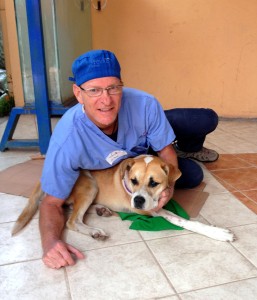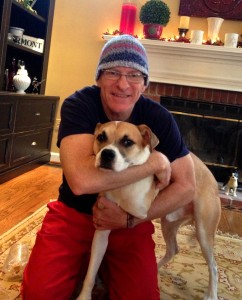
Dr. Joe Zulty in recovery with Puma after his leg amputation. World Vets Cusco, Peru project 2012.
It begins in the stone streets of Cusco, an ancient city of 600 thousand people, constructed by the Incas in the magnificent Andes mountains at 3,400 meters above sea level. There are many dogs in the streets, in doorways, everywhere. Unlike those of the U.S., these dogs are very talented. They know how to negotiate the streets, to stop at corners, and incredible how to avoid traffic.
Well, maybe not all of them.
On day two of World Vets spay/neuter clinic, three members of the Peruvian National Police, dressed in green uniforms, appearing strict and emotionless, delivered two dogs that had been running the streets. Both were discovered with 2 other dogs, all four belonging to a woman who loved them but unfortunately was not capable of providing for them. The older of the

Dr. Joe Zulty with Puma following World Vets project in Maryland, USA.
two was scruffy but OK, the younger one however needed our help. He had a paw that was completely paralyzed and severely swollen. Its appearance was that of the paw of the Puma in the ancient wall of the Saqsayhuaman ruins. And there was something else worth mentioning. Perhaps another sign from the Incas, I am not sure. It is that moment in time that captures your heart and gives a true relevance to why we do what we do.
One of the police officers, a woman who was especially very quiet and very reserved, spoke not with words but with the hardly noticeable tears in her eyes. Those wet eyes touched me, made their way to my heart, and reinforced what the Incas were trying to tell me.
So the next day, on the last day of clinic, with the help of local Peruvian veterinarian, Dr. Carmen Caceres, the paw that touched but did not feel the surface of the street, was removed. Incredibly this dog, just 2 hours after surgery, was awake, standing, and wagging his tail! That was when one of World Vets volunteers stated, “It is not too difficult to take a dog back to the U.S. We brought a dog back from Ecuador on a past World Vets project.”
With the assistance of Monica Chacon of Pataz Pro Animalista Cusco, officer Glenda Anchea Garavito, Dr. Edgar Ochoa and his colleagues at Lazzie Vet Clinic, and the spiritual support of the Incas, the process of transporting a dog from one hemisphere to another became a reality. The forces were too strong. It was meant to be I suppose. In the airport in Cusco, my son Zack and I , with our new pet Puma, said goodbye to our friends from Cusco and of course the conversation was full of tears. But special moments like this do not come often. I was proud to be a veterinarian. I was proud of having worked with people who make a difference in the life of an animal. And I am pretty sure the ancient Incas were smiling from above.
**This article was written by Dr. Joe Zulty, a World Vets field service veterinarian. This article reflects his participation on World Vets Cusco, Peru project in 2012 when Puma was assisted and then adopted. Dr. Zulty is leading a World Vets small animal project to Sosua, Dominican Republic in November 2013. Read more about this volunteer opportunity here.
World Vets has an upcoming volunteer opportunity to Cusco, Peru operating September 28 – October 5, 2013. Volunteer positions remain open for the tech/student category. This position can be filled by licensed vet techs, non-licensed vet techs, vet students, pre-vet students and vet tech students. Read more about this volunteer opportunity here



